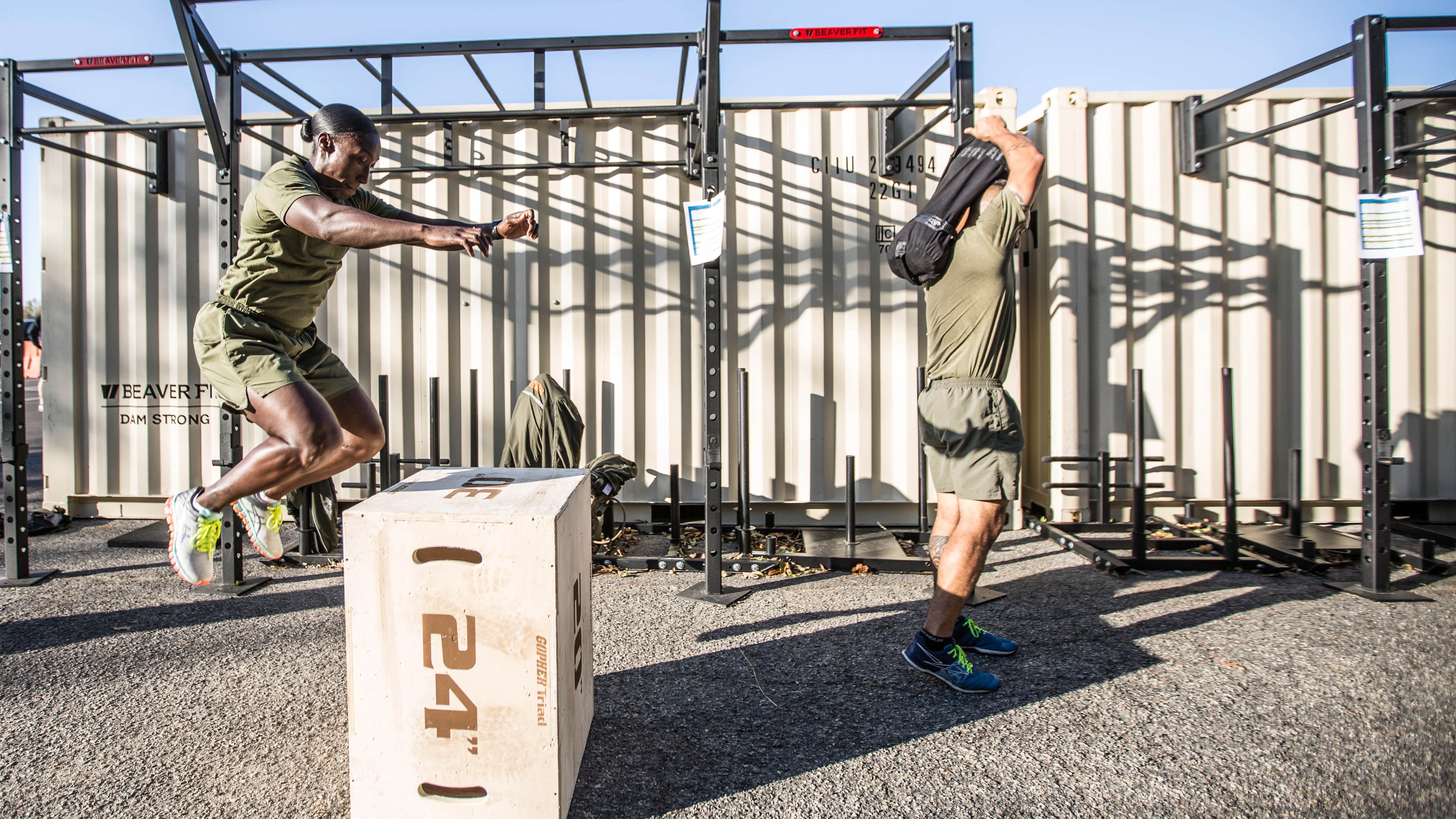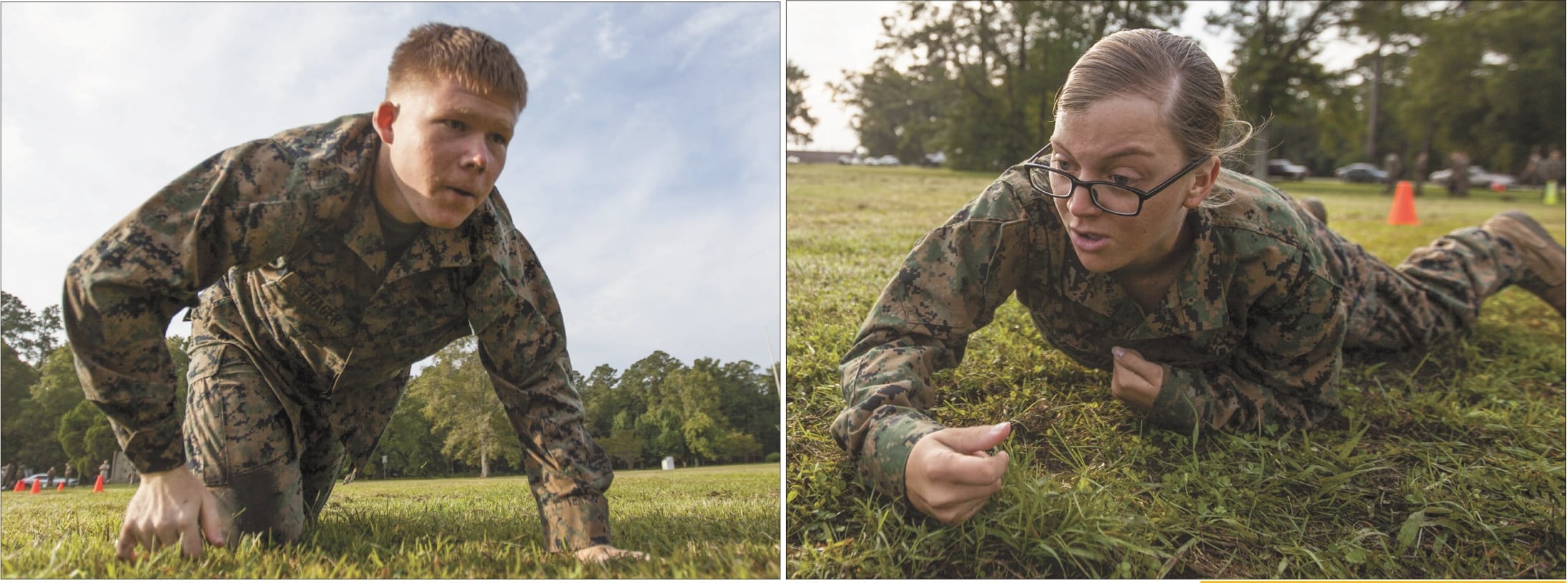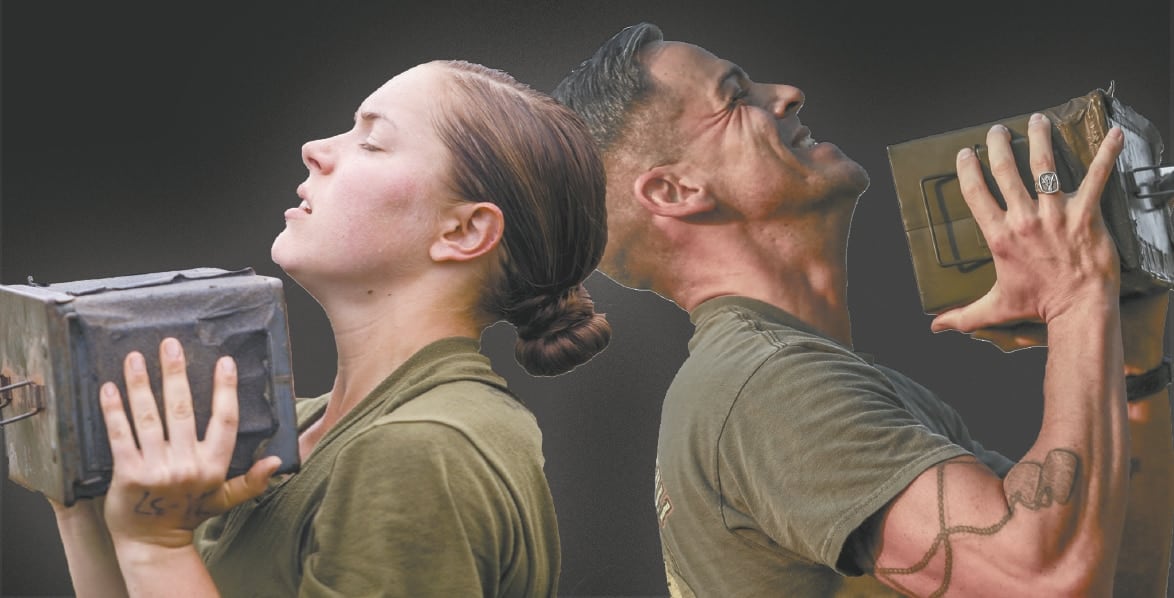For years, the Marine Corps has set fitness standards lower for women, a gesture of fairness based on the belief that women are inherently less strong and would be unable to meet the more rigorous requirements set for men.
But now that double standard is increasingly viewed by some as gender bias. There's mounting evidence, both inside and outside the Marine Corps, that female service members can actually meet the same standards as men for the forcewide benchmarks assessed by the Corps' Physical Fitness Test and the Combat Fitness Tests, known as the PFT and CFT.
"Whether intentional or not, the Marine Corps has been evolving toward a single fitness standard," said Lt. Col. Misty Posey, who has researched female fitness issues for years, and who takes command of the Corps' only female recruit training battalion this month.
Posey was a planner with the Marine Corps Force Innovation Office from 2014 to 2016 and led a research team that looked at gender-neutral options for the PFT and CFT, she said. The team’s focus was not whether the Corps should switch to a single physical standard, but rather whether such a standard is possible.
"The [Marine Corps research team] was optimistic that at some point in the future, if the decision was made to pursue a single fitness standard, it was within the art of the possible, given how far female Marines had come and still could go," she told Marine Corps Times.
"As we reviewed the history of Marine Corps-wide fitness testing, we were particularly intrigued by how much it had evolved, especially for female Marines. ... It seemed that when the Marine Corps realized women could be more fit, and needed female Marines to be more fit, we became more fit."
She stipulated that she is not advocating a change in the Marine Corps policy, but said she wants the public to be aware of her research.
Marine Corps officials say there are no current plans to change the forcewide policy to make the PFT and CFT gender neutral. Yet the idea of gender-neutral standards is a popular one among rank-and-file Marines. When a Marine Corps Times online reader poll asked whether the Corps should adopt a single fitness standard for men and women, 87 percent responded yes.
All four military services require different fitness standards for men and women. Yet views on the politically sensitive issue have been a topic of growing debate. Last year's Pentagon decision to integrate women into previously all-male combat arms units put a spotlight on standards and forced the Corps to adopt a general-neutral test for those specific jobs to allay concerns about diminished readiness.
Since January, the Marine Corps has made changes to the PFT and CFT that put men and women on more equal footing. Women now have to do more crunches, more ammo-can lifts and must perform the same pullups as men.
Culturally, the tradition of the two-tiered fitness standards has come under scrutiny. The scandal earlier this year with some male Marines posting pictures of nude female Marines online has raised concerns about sexism inside the force — and some Marines believe lower standards for women is fueling a bias.
"When individuals start out at the recruiting station and they see that women are held to lower standards and have a much lower fitness requirement to max out the PFT, that causes cultural reverberations down the line," said retired Lt. Col. Kate Germano, who was in charge of training female recruits at Parris Island. When women face lower expectations, they end up being less competitive than their male counterparts, Germano told Marine Corps Times.
Germano was fired in 2015 from her post at the Corps' only female recruit training battalion when her efforts to improve performance among female Marines caused controversy. Her commanders concluded that she had created a "toxic" command climate. Germano wrote an article for the Marine Corps Gazette with the inflammatory title of "When Did It Become an Insult to Train Like a Girl?" But the journal's editors canceled plans to publish it after Germano was fired.
Research like Posey's may undermine some long-held beliefs about the physiological differences between men and women.
"Women may even have a biological advantage over men in certain areas," Posey said.
Some studies have indicated that women, who make up about 7 percent of the active-duty Corps, are more resistant to fatigue during long, sustained exercise, and they recover more quickly from physical exertion.

Some studies have indicated that women, who make up about 7 percent of the active-duty Corps, are more resistant to fatigue than men during long, sustained exercise.
Photo Credit: Sgt. Melissa Marnell/Marine Corps
"If a man and a woman put the same amount of effort into a long, slow physical task — one that mostly involves muscle endurance or is more skill based — the woman will take longer to fatigue," Posey said. "The longer the race, the stronger women get."
Posey argues that raising the bar for women provides them an incentive to get stronger. For example, in 2016 only 15 percent of female Marines chose to do pullups on the PFT because, under the previous rules, they could get 100 points on the test by doing the flexed arm hang, which was phased out in January.
In 2017, the standard changed.
Now, "you can only get 100 points if you perform pullups on the test," Posey said. "So far this year, 74 percent of female Marines have elected pullups. This is a substantial increase in just one year. As a result of incentivization, female Marines are stronger and possess more dynamic upper-body strength" than they did before.
Measuring fitness
The PFT and CFT are meant to assess Marines' overall fitness, not how well they will perform their mission or in their military occupational specialty, said Capt. Joshua Pena, a spokesman for Training and Education Command.
While military fitness tests are widely viewed as a measure of readiness, experts say that's not the primary purpose.
"These standards are more of a public health question than a combat readiness issue," said Brian Schilling, chair of kinesiology and nutrition sciences at the University of Nevada, Las Vegas. "Health care is expensive, so we expect the armed forces to maintain health standards for personnel."
Having two separate fitness standards is the obvious approach, Schilling recently told Marine Corps Times.
"It is biologically correct to say that 'physically fit' for a woman is different than 'physically fit' for a man," Schilling said.
"This is based on sex differences in body composition, muscular strength, muscular endurance, cardiorespiratory endurance, etc."
Compared to women, men have larger hearts that can pump more blood and other physical advantages, said Dr. Elizabeth Joy, president of the American College of Sports Medicine.
World records show that men have consistently outperformed women at athletics, and that gender gap is likely due to differences between men and women that begin at puberty, said Joy, who is based in Salt Lake City.
As soon as boys see a surge in their testosterone levels, they become significantly stronger. That's why coed sports teams tend to be for children under the age of 11, she said. By adulthood, men have considerably bigger muscles than women for both endurance and explosions of energy.
However, strength can be measured in absolute terms or relative to body size. Men may tend to be larger than women, but the relative strength of male and female athletes is nearly equal to their size and how much muscle they have.
But Posey argues that most of the differences between how men and women perform on the PFT and CFT are attributable to factors that Marines can control, such as training, conditioning and diet.
Pavel Tsatsouline has trained female Marines to get stronger by using their muscles more effectively instead of building new muscle. Women who train this way can excel at pullups, weighted pullups and deadlifting heavy weights.
Instead of lifting the maximum weight possible, strength athletes will lift a moderate weight in as many sets as possible, and that trains their nervous systems to better engage their muscles, said Tsatsouline, a former Soviet Spetsnaz physical fitness instructor who has also advised the U.S. Marine Corps on strength training.
"It is very, very possible to restructure the training in such a manner to make all the Marines — men and women — so much stronger," Tsatsouline said. "You have plenty of people in the Corps who are just very passionate about this and know how to do this."
How it would work
A universal upper-body strength test would be the easier first step if implementing a single standard for men and woman, Posey said. A gender-neutral running test might be harder, she added.
This year the Marine Corps has narrowed the gap between men and women for upper body strength. Beginning this year, female Marines must do pullups on the PFT just like men, a big change from the previous flexed arm hang practice. The Marine Corps has now rejected the much-maligned flexed arm hang as an accurate test of strength.
Posey has also spent years researching and demonstrating that all female Marines can do as many pullups as men, flying in the face of stereotypes that women simply don't have enough body strength to properly do the exercise.
Last year, the Marine Corps released a video that showed Posey teaching Marines how to do pullups after a female Marine told Commandant Gen. Robert Neller that Posey's technique allowed her to finally lift herself above the bar.

There's mounting evidence that female service members can actually meet the same standards as men for the forcewide benchmarks assessed by the PFT and CFT.
Photo Credit: Lance Cpl. Andrew Kuppers/Marine Corps
Women in the Marine Corps have been required to do pullups since January. Right now, women between 17 and 20 years old need to do seven pullups to get a maximum score. Men that age must to 20 to get the same score.
Once they are given the chance to learn how to do the exercise and meet the current requirement, it is possible that female Marines can be scored the same as male Marines on the pullup event, Posey said.
"Female Marines are smaller, carry less body mass, and our muscles are less fatigue resistant, all advantages to pullups," she said.
"Fatigability" is an exercise-induced reduction in performance. Recent studies indicate that women are more resistant to muscle fatigue than men during long, sustained exercise.
"Men have faster-contracting fibers, which are better for powerful short movements, while women have a greater number of fatigue-resistant fibers, which are better for sustained, low-intensity exercise.
"Additionally, men have larger muscles that demand more blood, so their hearts have to work harder. If a man and a woman put the same amount of effort into a long, slow physical task — one that mostly involves muscle endurance or is more skill based — the woman will take longer to fatigue. The longer the race, the stronger women get," Posey said.
"The reason we do not always see this benefit manifest is most women are further from their athletic potential than men. Other research indicates that women are faster to recover from physical exertion than men, regardless of the intensity of the effort."
Creating a single standard for the ammo-can lift event on the CFT would be challenging but still possible, Posey said.
Under the latest standards, male Marines must lift a 30-pound can over their heads from shoulder height between 106 and 120 times within two minutes to get a maximum score, while women must lift the can between 66 and 75 times for the same score.
Although Marines with larger muscles clearly have an advantage in this exercise, women do not tire as quickly as men; so with the right training, it is possible that female Marines can gain the endurance to lift the can over their head more than 100 times, she said.
On the new PFT, the number of crunches women must do to get a maximum score has been increased from 100 to 110 — just five fewer than what men need to do to get a max score. And women now need to do between 66 and 75 ammo-can lifts on the PFT for a maximum score — a 42 percent increase for female Marines in their late 20s.
Crunches may be the easiest event to make gender-neutral, yet Posey stressed that women who have experienced abdominal muscle separation during pregnancy should not do crunches until they are fully healed.
On the PFT's run event, men must complete three miles within 18 minutes to get a maximum score, while women younger than 40 have 21 minutes.
The three-mile run would be one of the toughest events to make gender neutral because in general men's bodies can deliver more oxygen to their muscles and women's bodies, Posey said.
But aerobic training can improve oxygen flow to muscles by as much as 15 percent, and other factors that are divorced from gender can influence running performance, including leg length and circumference, center of gravity, running mechanics and movement economy, she said.
"As such, a single standard for running could be established that is attainable for both genders since performance can be improved with training, and neither gender would be expected to run at their 'upper limit,'" Posey said.
If the Marine Corps ever decides to establish a single physical fitness standard for men and women, it would be best to do so over time by setting reasonably attainable goals, Posey said.
"Essentially, some people will have to work harder than others to achieve the same physical performance, even when matched for size and gender, and it's not true that all women will always have to work harder than all men," Posey said.




